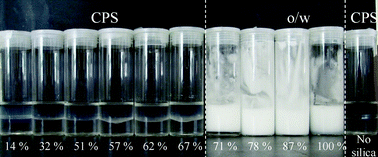Phase inversion of fumed silica particle-stabilised emulsions of water and perfume oil can be effected in three ways. The transitional inversion from water-in-oil (w/o) to oil-in-water (o/w) occurs upon increasing the particle hydrophilicity for 9 oils of different polarity and structure. Results are compared for systems in which particles are pre-dispersed in one of the bulk phases and for those in which a novel powdered particle method is used. Using a simple theory involving the surface energies of the various interfaces, the contact angle θ of a particle with the oil–water interface is calculated as a function of the particle hydrophilicity. Assuming phase inversion occurs at θ = 90°, very good agreement is obtained for all oils between the calculated and experimental particle hydrophilicity required for inversion in the case of the powdered particle method. Inversion from o/w to w/o induced by simply increasing the particle concentration is shown to be as a result of changes in the aggregation state of the particles influencing their wettability. Finally, catastrophic phase inversion from w/o to o/w is achieved by increasing the volume fraction of water, and multiple emulsions form around inversion in a system containing only one particle type. Results of the latter two inversion routes are combined to develop an emulsion compositional map allowing a variety of emulsions with different characteristics to be described by varying the relative amounts of the three components.

